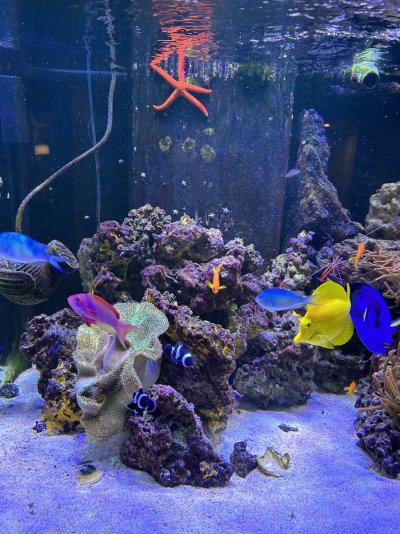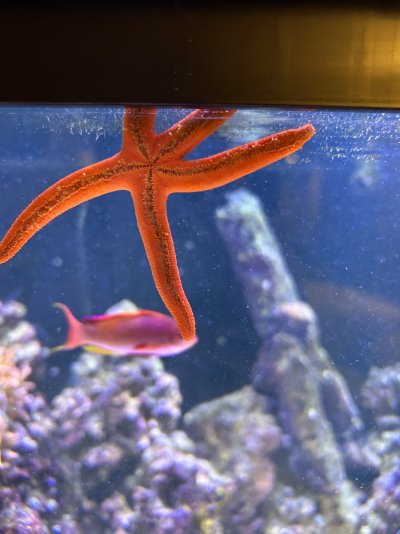I think i misunderstood your comment! I'm sorry! I thought you were being sarcastic! Yes, of course i can share with you! I apologize for that!Can you share the issue number and title of the article? I am trying to do a single Luce se but don’t see your article?
Navigation
Install the app
How to install the app on iOS
Follow along with the video below to see how to install our site as a web app on your home screen.
Note: This feature may not be available in some browsers.
More options
You are using an out of date browser. It may not display this or other websites correctly.
You should upgrade or use an alternative browser.
You should upgrade or use an alternative browser.
Observational Study of Fromia Starfish Species Fromia indica, Fromia milliporella, Fromia pacifica
- Thread starter livinlifeinBKK
- Start date
- Tagged users None
- Joined
- Aug 7, 2016
- Messages
- 439
- Reaction score
- 192
Hi livinlifeinbkk,
just received your article…. Will subscribe to the magazine now as all the articles were amazing. Glad they list you as a “new contributor”. Well done! You can respond directly if you prefer??
Can you identify the starfish species I have?? I actually am not confident on the fish store giving me an accurate name?
in the article your data chart doesn’t specify which starfish is what species?? Can you clarify?
I always feed my tank human grade clams ( thanks Paul B). I do wonder how this slow moving star fish is able to compete for this desired food source. I like your idea about isolation box feeding! I was nervous to do this based on hearing the starfish should not be exposed to air? But I could make the transfer underwater also. In reading your article tho / you did take them out to weigh them… and they were fine? In the wild I have seen them exposed to air on top of rocks so I suspect they would be fine.
I also want to document that my species is not as sensitive as people say… my tank is high in nutrients nitrate and I am not even dosing anything this year… I would say my nitrate is at 40 - 80
I am still not convinced that when they hang at the top of the tank w a foot out they need oxygen? I still think there is biofilm at that spot and my guy is feeding on it.
I am dosing phyto for my pod population and wonder if that is a factor?
For your research he arrived early January. 3 plus months in my tank. I feed live clams plus lrs reef & herbivore. Frozen mysis, cyclops, oyster eggs. I am also harvesting pods (tiger and tisbe) that I add every few weeks. And I dose phyto. tank is 3 years old 180 gallons built on LR from an existing tank 20 years old.
thanks for sharing..,


just received your article…. Will subscribe to the magazine now as all the articles were amazing. Glad they list you as a “new contributor”. Well done! You can respond directly if you prefer??
Can you identify the starfish species I have?? I actually am not confident on the fish store giving me an accurate name?
in the article your data chart doesn’t specify which starfish is what species?? Can you clarify?
I always feed my tank human grade clams ( thanks Paul B). I do wonder how this slow moving star fish is able to compete for this desired food source. I like your idea about isolation box feeding! I was nervous to do this based on hearing the starfish should not be exposed to air? But I could make the transfer underwater also. In reading your article tho / you did take them out to weigh them… and they were fine? In the wild I have seen them exposed to air on top of rocks so I suspect they would be fine.
I also want to document that my species is not as sensitive as people say… my tank is high in nutrients nitrate and I am not even dosing anything this year… I would say my nitrate is at 40 - 80
I am still not convinced that when they hang at the top of the tank w a foot out they need oxygen? I still think there is biofilm at that spot and my guy is feeding on it.
I am dosing phyto for my pod population and wonder if that is a factor?
For your research he arrived early January. 3 plus months in my tank. I feed live clams plus lrs reef & herbivore. Frozen mysis, cyclops, oyster eggs. I am also harvesting pods (tiger and tisbe) that I add every few weeks. And I dose phyto. tank is 3 years old 180 gallons built on LR from an existing tank 20 years old.
thanks for sharing..,


Last edited:
You may need a closer up pic of the top of the star for an ID (there are a lot of stars with similar coloration and shape).Can you identify the starfish species I have??
Yeah, starfish can be exposed to air without issue (though prolonged exposure would cause it to dry out, which would cause problems):I was nervous to do this based on hearing the starfish should not be exposed to air? But I could make the transfer underwater also. In reading your article tho / you did take them out to weigh them… and they were fine? In the wild I have seen them exposed to air on top of rocks so I Susie Ted they would be fine.
Actually, pretty much every Linckia species in the hobby (L. multifora & L. laevigata [genetically shown to be the same species, L. mulifora], L. columbiae, and L. guildingii) are all found in the intertidal zones as well as the subtidal. They are all fine to be exposed to air for some time (likely considerably longer than one would think), and, in fact, some people that keep or have kept starfish have reported them climbing up the glass and out of the water on occasion. As mentioned the important thing is just that they don't dry out.

True or False: If a starfish is exposed to air it will die
True or False: If a starfish is exposed to air it will die
 www.reef2reef.com
www.reef2reef.com
For those that have seen Fromia starve/disintegrate, how fast can they go from looking perfectly healthy to completely gone?
I ask because:
- had my red Fromia Indica for about 8 months
- looked completely healthy with no discoloration on arms/tips or anything like that
- went on vacation for 2 weeks
- came back and can't find a trace of it anywhere
*knew the consensus and expecting the worst but timing seems pretty weird
I ask because:
- had my red Fromia Indica for about 8 months
- looked completely healthy with no discoloration on arms/tips or anything like that
- went on vacation for 2 weeks
- came back and can't find a trace of it anywhere
*knew the consensus and expecting the worst but timing seems pretty weird
Most stars disintegrate in a matter of days to a week from what I've seen. A shop I worked at a while back would get Linckia laevigata (blue Linckia stars) in once and a while and some of them would go from looking fine on Day 1 to completely gone for unknown reasons within days. Two weeks is more than long enough for a star to completely disintegrate in my experience. It really is a rapid process and they literally do just "disintegrate".For those that have seen Fromia starve/disintegrate, how fast can they go from looking perfectly healthy to completely gone?
I ask because:
- had my red Fromia Indica for about 8 months
- looked completely healthy with no discoloration on arms/tips or anything like that
- went on vacation for 2 weeks
- came back and can't find a trace of it anywhere
*knew the consensus and expecting the worst but timing seems pretty weird
Hey, If you guys happen to be curious how environmental conditions in captivity may affect Blue Linckia stars and lead to their death, I wrote up an article about it that you should give a read. Just know that Its rather lengthy...
For those that have seen Fromia starve/disintegrate, how fast can they go from looking perfectly healthy to completely gone?
I ask because:
- had my red Fromia Indica for about 8 months
- looked completely healthy with no discoloration on arms/tips or anything like that
- went on vacation for 2 weeks
- came back and can't find a trace of it anywhere
*knew the consensus and expecting the worst but timing seems pretty weird
Not surprised, read through this thread:

An Attempt to Generate Benthic Biofilm for Substrate Feeders
Hey guys, so as some of you already know, I'm trying to develop a solution to feeding substrate-feeding starfish such as Fromias and Linckias among others in an effort to make it possible for more people to keep them. This is just one idea among others I've had over the past week and just...
 www.reef2reef.com
www.reef2reef.com
Yeah, in my magazine article that was published in February I wrote an entire section discussing how it would be exceedingly difficult (and exceedingly lucky) for biofilm to form in a captive system that's remotely similar in composition to that of a natural habitat. Plus we aren't sure what it is that's most important for their nutrition in the biofilm.Not surprised, read through this thread:

An Attempt to Generate Benthic Biofilm for Substrate Feeders
Hey guys, so as some of you already know, I'm trying to develop a solution to feeding substrate-feeding starfish such as Fromias and Linckias among others in an effort to make it possible for more people to keep them. This is just one idea among others I've had over the past week and just...www.reef2reef.com
Similar threads
- Replies
- 7
- Views
- 1,453
- Replies
- 11
- Views
- 228
















